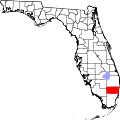Lauderhill, Florida | |
|---|---|
 Lauderhill City Hall | |
| Nickname: Jamaica Hill [1] | |
| Motto: "All-America City!" | |
 Location of Lauderhill in Broward County, Florida | |
| Coordinates: 26°9′56″N80°13′57″W / 26.16556°N 80.23250°W | |
| Country | United States |
| State | Florida |
| County | Broward |
| Incorporated | June 20, 1959 |
| Government | |
| • Type | Commission-Manager |
| • Mayor | Denise Grant |
| • Vice Mayor | Lawrence "Jabbow" Martin |
| • Commissioners | Melissa P. Dunn, Denise D. Grant, and Sarai "Ray" Martin |
| • City Manager | Desorae Giles-Smith |
| • City Clerk | Andrea M. Anderson |
| Area | |
| 8.57 sq mi (22.19 km2) | |
| • Land | 8.52 sq mi (22.06 km2) |
| • Water | 0.050 sq mi (0.13 km2) |
| Elevation | 9.8 ft (3 m) |
| Population (2020) | |
| 74,482 | |
| • Density | 8,747/sq mi (3,377.1/km2) |
| • Metro | 5,564,635 |
| Time zone | UTC-5 (Eastern (EST)) |
| • Summer (DST) | UTC-4 (EDT) |
| ZIP code(s) | 33311, 33313, 33319, 33351 |
| Area codes | 954, 754 |
| FIPS code | 12-39550 [3] |
| GNIS feature ID | 0285368 [4] |
| Website | www.Lauderhill-FL.gov |
Lauderhill is a city in Broward County, Florida, United States. It is a principal city of the Miami metropolitan area. As of the 2020 census, the city's population was 74,482.



